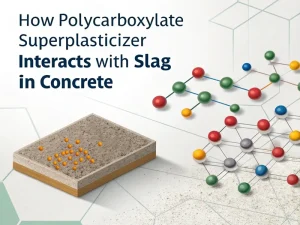Blog
In modern concrete technology, superplasticizers (also known as high-efficiency water reducers) are revolutionary chemical additives. It significantly reduces the water consumption of concrete through unique physical and chemical reactions while improving fluidity, strength, and durability. This article will analyze the various effects of high-efficiency water reducing agents on concrete and explore their role in improving concrete performance and performance.
One of the most significant effects of high-efficiency water-reducing agents on concrete is the improvement of its workability. Concrete workability refers to the ease with which fresh concrete can be mixed, transported, poured, and compacted without segregation or bleeding. When added to concrete mixtures, superplasticizers, typically high molecular weight polymers such as polycarboxylate ether (PCE) or naphthalene sulfonate formaldehyde (NSF), will adsorb onto the surface of cement particles.
These high-efficiency water-reducing agents endow cement particles with negative charges. Due to the mutual repulsion of the same charges, electrostatic repulsion can destroy the naturally formed flocs during the mixing process, effectively dispersing cement particles. This dispersing effect allows concrete to flow more freely and reduces internal friction between aggregates and cement slurry.
For example, in self-compacting concrete (SCC) applications, superplasticizers enable concrete to fill complex templates, reach hard-to-access areas, and flow around steel bars without the need for mechanical vibration. This not only speeds up the construction process but also minimizes the risk of honeycombing and voids, ensuring a smooth and dense concrete surface.
Another key function of high-efficiency water reducers is that they can reduce the moisture content in concrete while maintaining the required workability. In traditional concrete mixtures, achieving high levels of workability typically requires a relatively large amount of water. However, an excessively high water-cement ratio can lead to a decrease in the strength and durability of concrete over time. Superplasticizers provide a solution to this dilemma.
By effectively dispersing cement particles, superplasticizers enable concrete to achieve the same or even better workability with 30% less water. The decrease in moisture content directly affects the water-cement ratio, which is a key factor determining the strength and durability of concrete. A lower water-cement ratio results in a denser and more compact microstructure, as less water evaporates and leaves pores in the concrete matrix.
Superplasticizer plays a crucial role in improving the mechanical strength of concrete. As mentioned earlier, by reducing the water-cement ratio, superplasticizers help to form more compact and uniform concrete structures. The fewer pores, the denser the matrix, and the stronger the resistance of concrete to external forces.
In the early stages of concrete hydration, the reduced moisture content makes the reaction between cement and water more effective, resulting in the formation of more calcium silicate hydrates (C-S-H), which are the main bonding phases responsible for the strength of concrete.
Therefore, compared to traditional concrete mixtures with the same cement content, concrete containing superplasticizers has higher compressive strength, flexural strength, and tensile strength. This enhanced strength is particularly beneficial in applications where concrete needs to withstand heavy loads, such as in the construction of foundations, columns, and beams.
Durability is a key aspect of concrete performance, especially in structures exposed to harsh environmental conditions. Superplasticizers have made significant contributions to improving the durability of concrete in several aspects. The reduction of water cement ratio not only improves the strength of concrete but also reduces its permeability. Low permeability limits the entry of harmful substances such as water, chloride ions, and sulfates.
For example, chloride ions can penetrate concrete and cause corrosion of steel bars, leading to structural degradation. By minimizing the pores and capillary channels in the concrete matrix, superplasticizers help protect steel reinforcement and extend the service life of concrete structures.
In addition, superplasticizers improve workability and compaction, making concrete more uniform and reducing the possibility of defects that may affect its durability. This makes superplasticizer-reinforced concrete very suitable for application in coastal areas and freeze-thaw cycle areas, where structures are often exposed to saltwater spray.
Superplasticizers also make the development and application of special types of concrete possible. As mentioned earlier, self-compacting concrete is such an example. SCC has changed the construction industry by allowing for faster and more efficient construction, especially in complex structures.
Another example is high-performance concrete (HPC), which is characterized by high strength, low permeability, and excellent durability. Superplasticizer is an important component of high-performance concrete mixtures, which can maintain workability while achieving the desired performance during pouring.
In addition, ultra-high performance concrete (UHPC) typically relies on high-efficiency water reducers to reduce its moisture content to extremely low levels, resulting in compressive strength exceeding 150 MPa. UHPC is used for applications where high strength and durability are crucial, such as the construction of prefabricated bridge components and thin shell structures.
In summary, high-efficiency water-reducing agents have a profound impact on concrete, significantly improving its workability, reducing moisture content, enhancing mechanical strength and durability, and making the use of special types of concrete possible. With the continuous development of the construction industry, the role of superplasticizers in creating stronger, more durable, and more efficient concrete structures will only become more crucial.

How Polycarboxylate Polyether Monomer Affect Concrete Performance
Blog How Polycarboxylate

How Polycarboxylate Superplasticizer Interacts With Slag In Concrete
Blog How Polycarboxylate